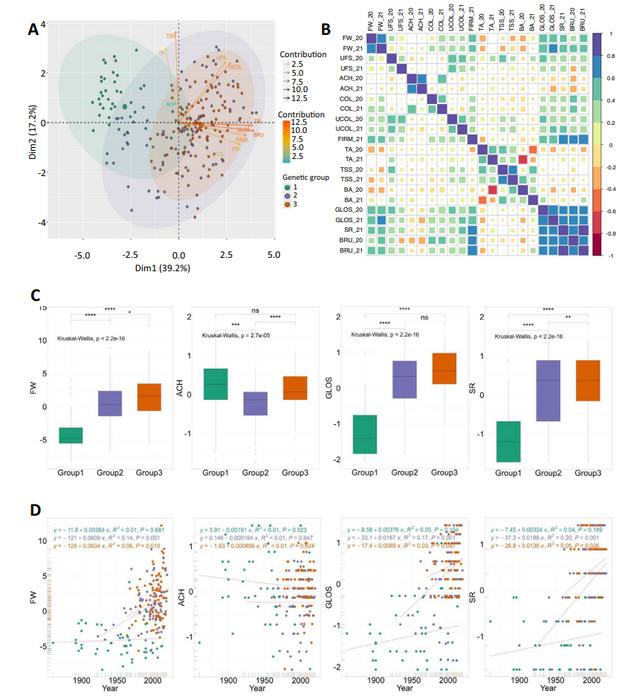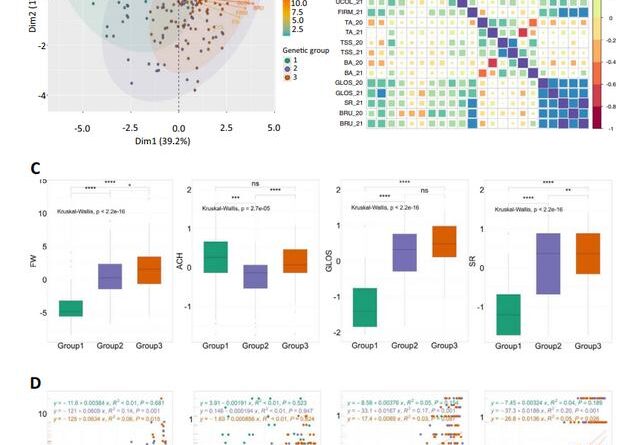Unlocking the genetic secrets of strawberries for high fruit quality

picture:
Phenotypic changes across the three genetic groups of the panel.
vision Again
Credit: Horticulture Research
Strawberries, valued for their taste and health benefits, have been at the forefront of breeding programs focused on improved sensory and nutritional properties. Despite progress, the complex genetic makeup of these fruits has hampered efforts to improve them. This new study provides breakthroughs in the identification of key genetic markers and genes that control quality traits, enabling more efficient and effective breeding methods to grow juicy, vibrant and sustainable strawberries. long time.
Strawberry breeding faces the challenge of balancing genetic diversity with the improvement of fruit quality characteristics such as firmness and flavor. Traditional breeding methods have often struggled to meet these two needs. Recent developments in genetic research, particularly genome-wide association studies (GWAS), have provided new opportunities to explore and improve these traits. Based on these challenges, there is a strong need to conduct in-depth research on the genetic factors that influence fruit quality in strawberries, using the wide range of genes available in European strawberry cultivars. .
Researchers at the University of Bordeaux, in collaboration with Invenio, have made significant progress in strawberry research. Their findings (DOI: 10.1093/hr/uhae137), published in the journal Horticulture Research On May 14, 2024, examine the genetic modification of strawberry varieties and identify molecular markers for breeding programs, with the aim of enhancing fruit weight, firmness, shape and appearance.
The study discovered important genetic markers associated with important fruit quality traits, such as fruit weight, firmness, and gloss. Using GWAS, the researchers found 71 associations with 11 different qualitative traits, confirming known markers and discovering new quantitative trait loci (QTL). Notably, three of the top six cultivars are associated with glossiness and skin resistance—characteristics that increase the fruit’s appeal and shelf life. These findings indicate significant improvements in breeding conditions achieved across European and American species. The study also highlighted areas of reduced genetic diversity due to selection pressure, highlighting the effect of breeding on genetic diversity. This research highlights the importance of untapped genetic resources in European strawberries, offering promising opportunities for breeding programs to improve fruit quality without compromising flavor and color.
Dr. Béatrice Denoyes, one of the main researchers, said, “This research provides a comprehensive view of strawberry genetic diversity and its impact on fruit quality. for growers and consumers.”
The findings of this study have significant implications for strawberry breeding programs. By using newly identified genes, breeders can successfully select traits that improve fruit quality, such as firmness and shine. This will not only improve the consumer experience but also reduce post-harvest losses, which will contribute to sustainable farming practices.
###
References
DOI
10.1093/hr/home137
Original Source URL
https://doi.org/10.1093/hr/uhae137
Financial information
The project was funded by the Region of Nouvelle-Aquitaine and the European Regional Development Fund (ERDF) (REGINA project number 67822110; AgirClim project No. 2018-1R20202); and the European Union Horizon 2020 research and innovation program (BreedingValue Project No. 101000747; PRIMA-Partnership 2019–22 Med-Berry project).
About Horticulture Research
Horticulture Research is an open access journal of Nanjing Agricultural University and ranks first in the Horticulture category in Journal Citation Reports™ from Clarivate, 2023. The journal aims to publish original research articles, opinions, opinions , comments, articles and letters to the editor related to plants and all major horticultural disciplines, including biotechnology, breeding, cellular and molecular biology, evolution, genetics, species relations , physiology, and the origin and breeding of crops.
Journal
Horticulture Research
Research Topic
It doesn’t work
Article Title
Screening of a panel of strawberry varieties in central Europe to provide markers and genes for fruit quality control.
Publication Date of Articles
14-May-2024
Definition of COI
The authors declare that they have no competing interests.
Description: AAAS and EurekAlert! are not responsible for the accuracy of the information published on EurekAlert! by participating in organizations or for the use of any information through the EurekAlert system.
#Unlocking #genetic #secrets #strawberries #high #fruit #quality
